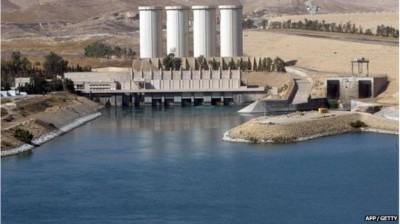Iraq: Leaky Plans to Fix Mosul Dam Cause Tsunami Fears

The Mosul dam is built on a bedrock of Gypsum, which dissolves in water [AFP]
Experts have warned of renewed fears that the Mosul Dam, once named “the most dangerous dam in the world”, may break open in Spring 2017, causing untold damage on ‘biblical proportions’.
Engineers and scientists have been warning of the potential for a massive catastrophe for years, as decades of neglect have caused structural damage that requires daily repair.
“If there is a high flood in the spring, then no-one knows what is going to happen,” said Nadhir Al-Ansari, professor in geotechnical engineering at Lulea University in Sweden.
The discharge from a flood on the Tigris is so huge and if there is a snow-melt I don’t think the dam will hold this Spring.
It’s not possible to predict the exact effects of 11 km3 of water suddenly emptying out on to the local population.
A European Commission report from April 2016 estimated that a 26 percent rupture in the dam would cause a 10 metre high wave which would sweep through Mosul, hitting 270,000 people. A total of six million people would be affected by flood waters exceeding two metres.
By way of comparison, the 2004 Tsunami in the Indian Ocean killed around 250,000 people in 14 countries, causing one of the most widespread humanitarian disasters of all time.
The US embassy in Baghdad warned in a 2006 report that a rupture could raise water levels in Mosul, Iraq’s second city, by 13.7 metres in four hours – quite literally submerging large parts of the city by one storey.
“Mosul Dam faces a serious and unprecedented risk of catastrophic failure with little warning,” said the US Embassy in Baghdad in a report.
A catastrophic breach of Iraq’s Mosul Dam would result in severe loss of life, mass population displacement, and destruction of the majority of the infrastructure within the path of the projected flood wave.
The Mosul dam is currently being maintained by the Italian contractor, Trevi, which is engaged in the process of grouting, the process of injecting cement into areas of weakness.
But this process of grouting was criticised by the US army engineers corps in 2007 as insufficient, after it found that reinforcing one area allegedly caused increased pressure on other areas of weakness.
“Grouting at one location causes the flow path (seepage) of subsurface water to move to another location, but does not stop the seepage,” the report read.
Without continuous maintenance, this gypsum foundation disintegrates and the dam is allowed to sink in its middle, causing cracks in the wall and eventual disaster.
And, excluding the previous three months of emergency repair, there has not been any continuous maintenance on the dam in almost two years.The dam’s structural problems lie in its initial foundations. The dam was built on gypsum, a soft mineral which dissolves in water. As such, the dam’s foundations are facing constant erosion from the matter it is trying to contain, no matter how much grouting is done.
Without continuous maintenance, this gypsum foundation disintegrates and the dam is allowed to sink in its middle, causing cracks in the wall and eventual disaster.
Islamic State [IS] fighters took the dam from Kurdish control in August 2014, thereby halting the grouting operations until Trevi resumed them in around October 2016.
Even after the dam was recaptured by Kurdish Peshmerga forces, IS were still able to extract energy from the hydroelectric dam to power Mosul. American engineers informed the Kurdish officials that closing the turbines would create excess pressure on the dam, making it more likely to break.
Those fears became more pronounced in January 2016, when Iraqi Prime Minister Haider al-Abadi forced officials to investigate reports that new and perilous cracks had formed in the dam. Weeks later, the government warned citizens to relocate at least 5 km away from the river – in case of breach.
Those cracks have not gone away and concerns are being raised that not enough is being done to stabilise the dam come spring-time, with the increased pressure that a snow-melt would bring.
“Grouting operations will not end the problem,” said Ansari, “it urgently needs proper repair.”

